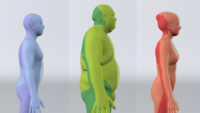
Respiration induces changes in torso shape and posture. We learn a model of how 3D breathing deformations relate to lung volume and breathing type and use it to animate bodies of varying shape and pose. Here we show the maximal inhale and exhale shapes overlaid for three different bodies breathing mainly with the stomach (left), mainly with the chest (right), or using a combination of chest and stomach (middle).
Modeling how the human body deforms during breathing is important for the realistic animation of lifelike 3D avatars. We learn a model of body shape deformations due to breathing for different breathing types and provide simple animation controls to render lifelike breathing regardless of body shape. We capture and align high-resolution 3D scans of 58 human subjects. We compute deviations from each subject’s mean shape during breathing, and study the statistics of such shape changes for different genders, body shapes, and breathing types. We use the volume of the registered scans as a proxy for lung volume and learn a novel non-linear model relating volume and breathing type to 3D shape deformations and pose changes. We then augment a SCAPE body model so that body shape is determined by identity, pose, and the parameters of the breathing model. These parameters provide an intuitive interface with which animators can synthesize 3D human avatars with realistic breathing motions. We also develop a novel interface for animating breathing using a spirometer, which measures the changes in breathing volume of a “breath actor.”


